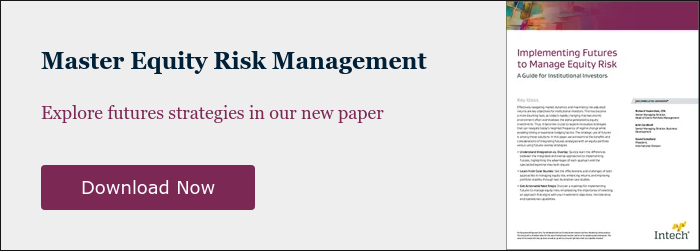For institutional investors, it’s not enough to simply identify effective strategies for managing risk and enhancing returns. The real challenge lies in the implementation. How do you take a theoretical concept and apply it in a practical, effective manner within your portfolio? This is the question we’ll address in this post, focusing on the implementation of futures for risk management.
- Understanding Your Objectives
The first step in implementing a futures strategy is to clearly define your investment objectives. These objectives serve as the guiding light for your strategy, shaping its design and execution. They should reflect your desired balance between risk and return and align with the broader goals of your portfolio and organization. What are you trying to achieve? What level of risk are you comfortable with? These questions form the foundation of your investment strategy. In the context of futures, your objectives might include managing equity risk, enhancing returns, or improving portfolio stability. A well-defined set of objectives and a clear understanding of your risk tolerance are the foundation of a successful futures strategy. They provide the direction and boundaries within which the strategy operates, guiding its implementation and ongoing management.
- Assessing Risk
Once you’ve defined your objectives, the next step is to assess the risks in your portfolio. Equity risk, the fluctuation in stock prices, is often the most immediate concern for investors. However, changes in interest rates can also significantly impact your portfolio, especially in a volatile rate environment. Credit risk, the possibility of a borrower defaulting on their debt obligations, can pose a threat in times of economic uncertainty. Geopolitical risk, the potential for political events to negatively impact your investments, is another factor that can’t be ignored in today’s interconnected global economy. Futures can be a powerful tool for managing these risks, but they also introduce their own set of risks. Therefore, a comprehensive risk assessment is a critical step in implementing a futures strategy.
- Choosing the Right Approach
There are two main ways to implement futures in your portfolio: integrated futures strategies and overlay strategies. Each approach has its own benefits and considerations.
| Integrated Approach | Overlay Approach |
| Assess the potential benefits and challenges of integrated futures strategies. Consider their ability to potentially provide direct control over equity risks, increase alpha, enhance governance efficiency, optimize capital efficiency, and potentially offer competitive fees. Engage in in-depth discussions with investment managers experienced in integrated strategies to fully understand their approach and track record. | Explore the merits of overlay strategies as a comprehensive risk management tool. Assess their ability to potentially manage portfolio-wide risk, add alpha, facilitate efficient rebalancing, and provide liquidity management solutions. Collaborate with experienced overlay managers who can customize the strategy to your portfolio’s unique risk profile and investment objectives. |
- Implementing the Strategy
Once you’ve chosen the right approach, the next step is to implement the strategy. Implementing a futures strategy is a multi-faceted process that requires careful planning and execution, including setting up the necessary infrastructure, allocating resources, and establishing governance structures. It’s important to ensure that your governance structure and oversight capabilities align with your chosen strategy. Do you have the necessary expertise with the tools and resources to monitor futures holdings? Can you dedicate a team to continuously monitor and adjust an overlay strategy?
- Monitoring and Adjusting the Strategy
The implementation of a futures strategy is not a one-time event but an ongoing process that requires continuous monitoring and adjustment. This is especially crucial for overlay strategies to ensure that the strategy remains aligned with your investment objectives and adapts to changing market conditions.
Monitoring involves tracking the performance of your futures contracts and assessing the overall risk of your portfolio, while adjusting the strategy involves making changes to your futures portfolio based on your monitoring activities. These tasks require specialized expertise; therefore, it’s essential to have a dedicated team or consultant with the necessary skills and experience to manage this process effectively, especially for overlay strategies.
- Communicating with Stakeholders
Finally, it’s important to maintain open and transparent communication with all stakeholders, including plan beneficiaries, board members, and investment committee members. It’s important to articulate why this approach aligns with the portfolio’s investment objectives and risk tolerance. This includes explaining how futures can help manage equity risk, enhance returns, and provide downside protection in volatile markets. It’s also key to discuss the potential risks and challenges associated with futures trading and how these are being managed.
Regular updates on the strategy’s performance and risk management outcomes are also vital. These updates should provide a clear picture of how the futures strategy is contributing to the portfolio’s overall performance and whether it’s meeting its risk management objectives.
Implementing futures for risk management is a complex process that requires careful planning, execution, and monitoring. But with the right approach and the right expertise, it can be a powerful tool for managing equity risk and enhancing returns in today’s market dynamics.



